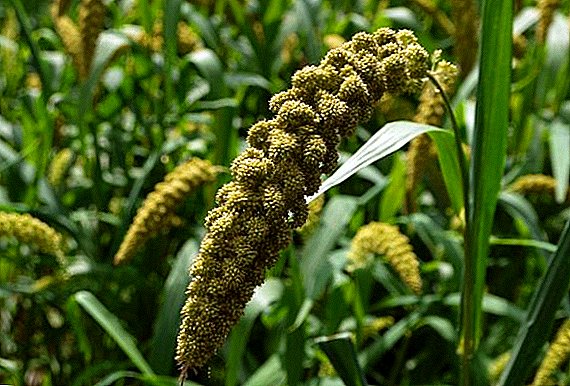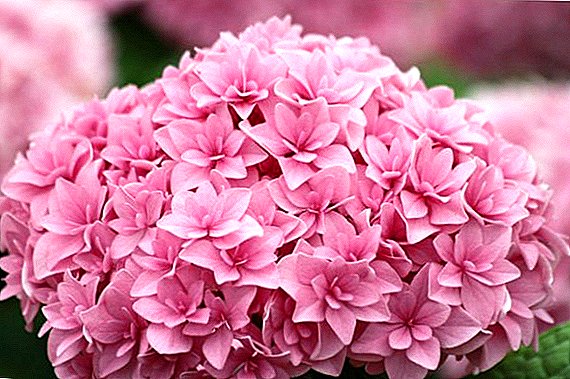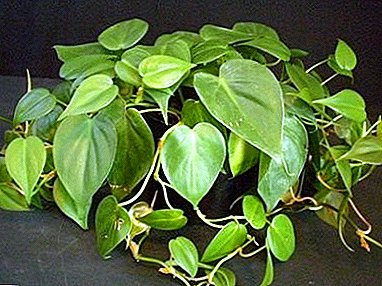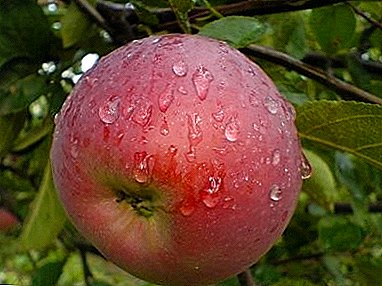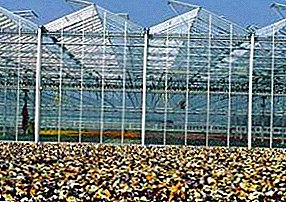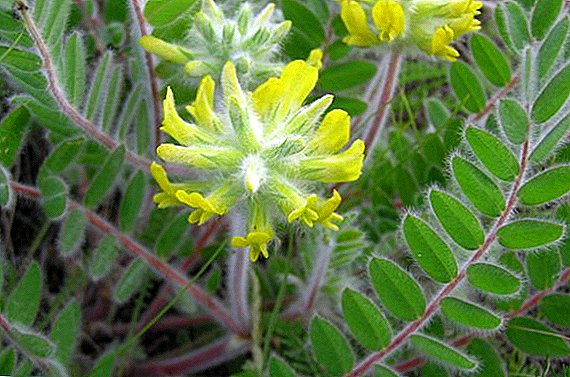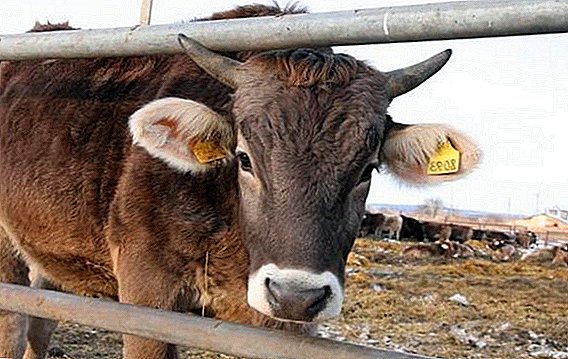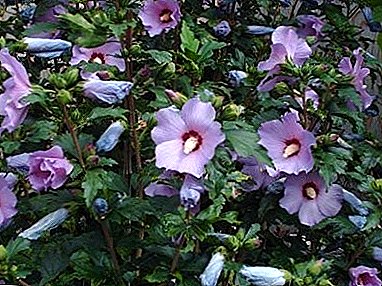
In the tropics - it is the decoration of the streets, in our gardens - an exotic guest. At home, in Haiti, hibiscus is used to decorate wedding ceremonies, and in Egypt, the drink of its flowers - hibiscus - is considered a drink of strength and vigor. The area of its distribution is great - it is China, India and the whole of Southeast Asia.
Hibiscus garden received the recognition of our gardeners for unusually large beautiful flowers of various shades and for their unpretentiousness. In nature, it has more than 200 species, and thanks to the efforts of breeders in the gardens, more than 500 hybrid varieties bloom.
Characteristics and description of garden hibiscus
Hibiscus is an annual herbaceous or perennial tree plant belonging to the family Malvaceae, it can be divided into three groups:
- shrub and shrub;
- grass hibiscus;
- treelike
 Low-growing grassy species, reaching 80 cm, are good as separate plantings, they can successfully disguise unsightly places in the garden or unsightly outbuildings. A shrub growing up to 3 meters will be a beautiful blooming hedge with which you can zone a plot. In short, hibiscus is very good at landscape design.
Low-growing grassy species, reaching 80 cm, are good as separate plantings, they can successfully disguise unsightly places in the garden or unsightly outbuildings. A shrub growing up to 3 meters will be a beautiful blooming hedge with which you can zone a plot. In short, hibiscus is very good at landscape design.
In tropical countries, the streets of cities are decorated with low, densely flowering trees.
In temperate climates, Syriac hibiscus caught on better than any other species because of its frost resistance. In the indoor version, growers prefer Chinese hibiscus or, as it is most often called, Chinese rose.
Caring for them is somewhat different, the houseplant requires more effort to maintain it in a flourishing decorative state. Although even during the rest period, when the bush is just green, it looks great in the interior.

Root system
Hibiscus root system mixed - There is a taproot, which is then covered with a variety of shoots. Growing root system quickly, therefore room option hibiscus need replant frequently as it grows.
No need for transplanting hibiscus, it can perfectly grow in one place for many years with good care.
Trunk
In shrubs and small trees, the trunk is covered with bark. You can grow standard plants, but only in tubs. Some gardeners plant for this purpose two or three varieties with different shades of flowers.
Twisting their trunks as they grow, you can get a beautiful tricolor tree.
In gardens, you can grow all kinds of hibiscus - herbaceous, shrub and tree.
Flowers and leaves
 Leaves of all varieties of hibiscus large (up to 5 cm) bright green. In different varieties, the leaves can be of different shapes - just oval, with a clove around the edge and three-segment. The Chinese rose leaves are smooth and shiny, while the garden (Syrian) leaves are frosted, slightly pubescent.
Leaves of all varieties of hibiscus large (up to 5 cm) bright green. In different varieties, the leaves can be of different shapes - just oval, with a clove around the edge and three-segment. The Chinese rose leaves are smooth and shiny, while the garden (Syrian) leaves are frosted, slightly pubescent.
Flowers - the main decoration of the plant - can be double and simple, red, pink, yellow, white and purple. However, breeders have tried so that everyone can find a flower to their liking. Hibiscus Flowers large - up to 13 cm in diameter.
Hibiscus garden - growing and care
With little effort, hibiscus will decorate the garden from early June to early September with bright, incessant flowering. This tropical guest requires no more care than other flowering plants.

The choice of hibiscus in the garden (light and thermal conditions)
Before planting hibiscus, it is necessary to determine the place where it will be comfortable. It is necessary to choose it, based on the characteristics of the plant and given that He may not need a transplant for many years.
Hibiscus will grow well and bloom in a sunny placewhere there are no strong drafts.
Light penumbra he can still move, but a strong shadow does not suit him, it will adversely affect flowering.
Planting in open ground
 Choosing a place, you need to prepare it. The soil must be air and water permeable, therefore, peat and sand must be mixed into the ground. Organics in the form of humus also does not hurt. An ideal option would be adding perlite and chopped bark. The reaction of the soil should be slightly acidic, well drained.
Choosing a place, you need to prepare it. The soil must be air and water permeable, therefore, peat and sand must be mixed into the ground. Organics in the form of humus also does not hurt. An ideal option would be adding perlite and chopped bark. The reaction of the soil should be slightly acidic, well drained.
Then a pit is prepared for planting. As a rule, the plant is transplanted from the tank in which it was grown from seeds or cuttings. Pit must be deeper and wider than this capacity. Before planting, pour about 5 liters of water into it. As soon as the water is absorbed into the ground, the hole is ready for planting. The plant is lowered vertically into the ground.
In cool climates, hibiscus need to be planted deeper than heat. In southern areas during planting it is recommended to leave part of the roots above the ground.
Planting hibiscus produced in early spring.
Transplant garden hibiscus is almost not needed. But if such a need arose, it should be done also in early spring and using the same technology as the landing.
Watering
Hibiscus does not tolerate excessive moisture, so you need to water it only after waiting for the soil to dry. But you can not overdry it.
It is better to water abundantly, but not very often.

Air humidity
There are no special requirements for air humidity for garden hibiscus. In the case when it is transferred to the building for the winter (for example, the standard specimen grown in a tub), it should be spray.
Top dressing
Hibiscus thank lush long bloom for proper feeding. Plant loves fertile landtherefore during the season it should be fertilized every 2 weeks.
To do this, use fertilizers with a phosphorus content and a small amount of nitrogen mixed with organic fertilizers. When preparing for wintering, potassium is added to the fertilizer so that the hibiscus can tolerate the low temperature well.
Bloom
 Hibiscus bloom begins in mid-June and ends in early September. A feature of it is the bud life. Having bloomed out in the morning, it may wither and fall off in the evening, and the next day a new flower appears on this spot.
Hibiscus bloom begins in mid-June and ends in early September. A feature of it is the bud life. Having bloomed out in the morning, it may wither and fall off in the evening, and the next day a new flower appears on this spot.
Pruning
Trimming is a necessary procedure for hibiscus. To it it is necessary to prepare a tool - pruners, a knife, a small hacksaw, if the branches are not amenable to pruning with a lighter tool. All this must be sanitized and ground. Blunt tools can damage the plant.
Branches are cut along the oblique, with the lower edge of the cut should be directed inside the bush, and the top - out. It should not be cut more than 23 lengths of branches, it can destroy hibiscus.
Pruning is subjected to only tree hibiscus and shrubs.
Types of pruning
1. Spring pruning, stimulating flowering.
The structure of the hibiscus is such that the bud is always formed at the end of the branch. Pruning branches in the spring by one third of last year's growth stimulates the growth of additional branches, at the ends of which the flowers will bloom.
 2. Forecutting or hygienic pruning.
2. Forecutting or hygienic pruning.
If the branches grow too thick, they should be thinned out, removing weak and dried shoots, as well as old branches. At the same time you need to inspect the plant for the presence of beetles, which can eat fresh shoots with buds.
Sick or damaged branches are cut to healthy tissue. A sign will be the green color of the wood on the cut. If it is white, then this part of the branch is inanimate.
3. Corrective pruning.
A bush that has grown strongly or has lost its shape can be trimmed, in order to return it to a beautiful neat shape. Cut single branches, strongly protruding above the crown of the bush. Pruning is about 13 lengths just above the nearest bud.
4. Radical pruning.
This is done if the plant is threatened with death. All branches are cut off almost completely. If the plant remains living tissue, then we can hope that the bush will be able to revive again.
5. Autumn pruning.
Held in September, after flowering. You can not cut the plant in late autumn before the onset of cold weather, otherwise in the spring it will not be able to give normal growth.
Young plants should only do soft pruning. in the form of pinchingI. In this case, only the tops of the branches are cut so that they can branch and give more flowers.
Hibiscus reproduction

Hibiscus breeds well and does not require special conditions for the growth and development of young shoots.
There are several ways of reproduction:
- seeds;
- cuttings;
- division of the bush.
Reproduction by cuttings
- Cuttings are cut in the summer with young shoots. They should have 2-3 points of growth.
- The cut is treated with a root or other growth stimulator and planted into a mixture of sand and peat 1: 1.
- The temperature of the content should not be below +23 degrees. Rooting occurs about 3-4 weeks after planting.
- Rooted cuttings are transplanted into the substrate from the fertile land with humus and sand and well watered.

Seed propagation
- Seeds are presoaked for a day in a growth stimulant solution;
- they are also sown in a mixture of sand and peat at a distance of 5-7 mm from each other;
- the container is covered with a film or glass;
- watering and ventilation are constantly carried out;
- temperature regime not less than +25 degrees;
- A dive is made when a few leaves appear.
Soil with seed planted requires bottom heating.
Hibiscus grown from seeds, usually blooms in the third year.
Reproduction by dividing the bush
- the bush is completely dug out of the ground;
- a sharp knife rhizome is divided into parts;
- planted as described above in the section "Planting in open ground."
Features care in the fall
 In the fall, hibiscus is prepared for safe wintering. To this end, in September, light pruning and fertilizing with potash fertilizers is carried out.
In the fall, hibiscus is prepared for safe wintering. To this end, in September, light pruning and fertilizing with potash fertilizers is carried out.
Before the onset of frost a bush is watered once and very abundantly. After a few days, his spud.
In November, the plant must be warmed with mulching and shelter.
Branches bend down to the ground and covered with a special cloth.
Above the young bushes you can put the arc and also cover them with a cloth. This can be done when the temperature outside is below +5 degrees.
Problems, diseases and pests
Problems you may encounter while growing hibiscus:
- dropping of flower buds means poor nutrition or excessive watering;
- yellowing of the upper leaves and dropping of the lower leaves - an excess of iron in the water for irrigation;
- the abundance of green mass and the absence of flowering - a surplus of nitrogen in the fertilizer;
- drooping leaves - lack of moisture.
The disease to which this plant is exposed is chlorosis. This is a fungal disease. It can be infectious and non-infectious. Infectious chlorosis is transmitted by insect pests, so the first step is to fight them.
The diseased plant needs to be transplanted to another location, strengthened feeding and regularly sprayed.
Non-infectious chlorosis can occur in case of excess moisture or if hibiscus grows in the shade. Need to transplant it in a brighter place and adjust the watering mode.
Pests:
- Aphid. It is a carrier of infection and damages the plant itself, especially the young.
- Fungal mosquitoes lay eggs and eat the plant.
- Thrips and gall midges affect the buds, which leads to their falling off.
- A mealybug and a spider mite cover the leaves with yellow and whitish spots.

Insect control agents are insecticidal products that are sprayed with a bush.
From fungal mosquitoes well helps soap solution, which can be added to the fertilizer and spray them with space around the bush.
Useful properties of hibiscus
In addition to the luxurious appearance of hibiscus has undoubted, proven for centuries health benefits. Indoor varieties perfectly purify the air in the room.
Virtually all parts of the plant are edible and high in vitamins. Carcade tea has the ability to regulate blood pressure, contains antioxidants and substances that restore the function of the liver.
The flower is not only beautiful, but also useful, not difficult to care for and able to live long and delight its owners with bright colors throughout the summer.
A photo
More photos of hibiscus garden see below:







